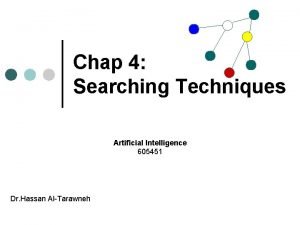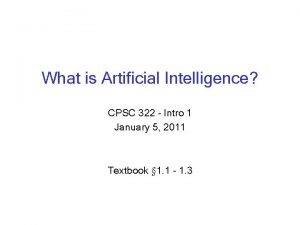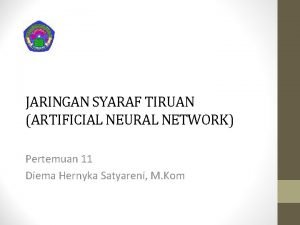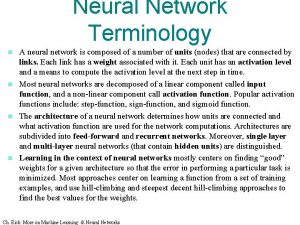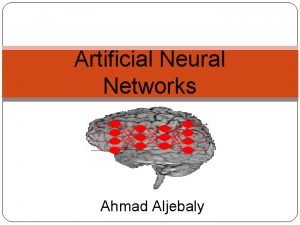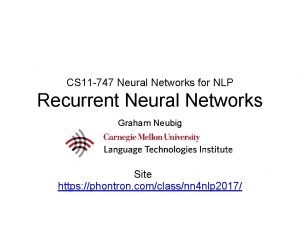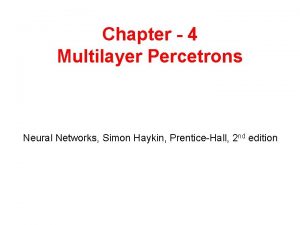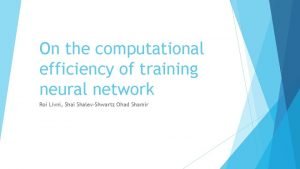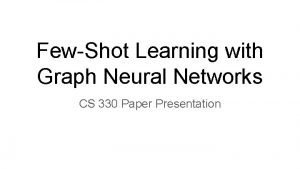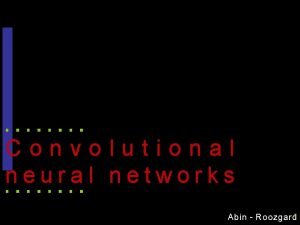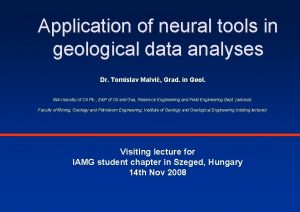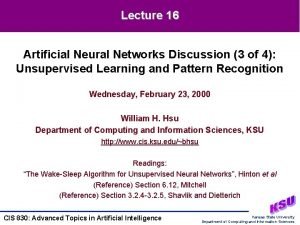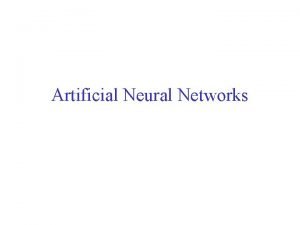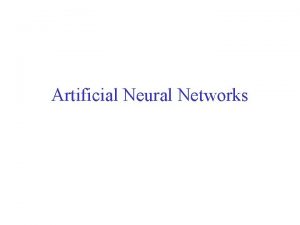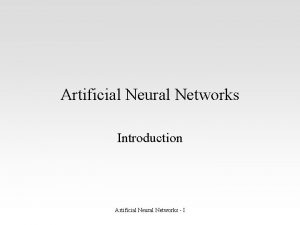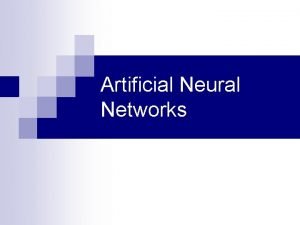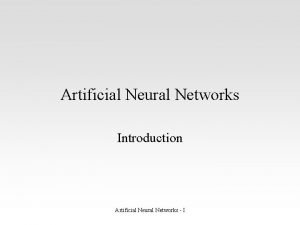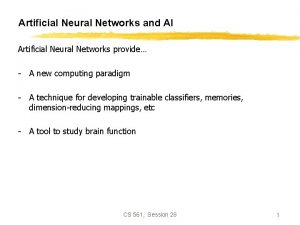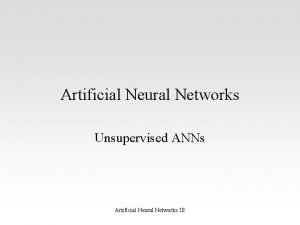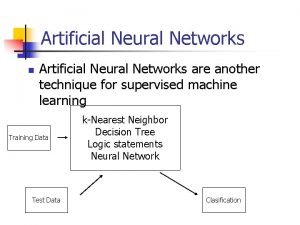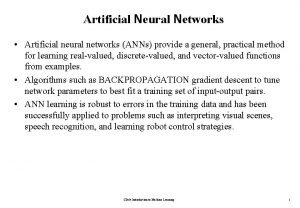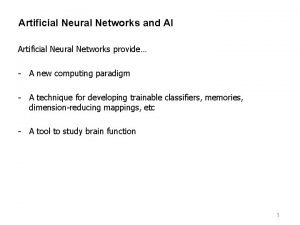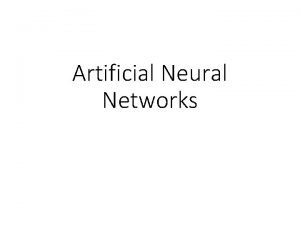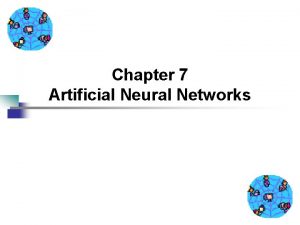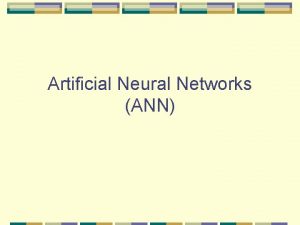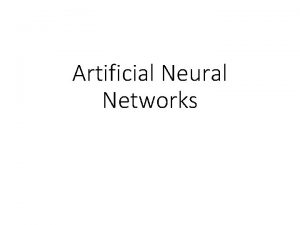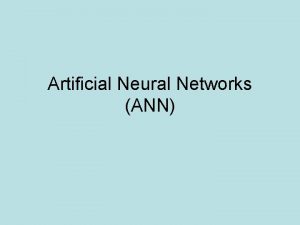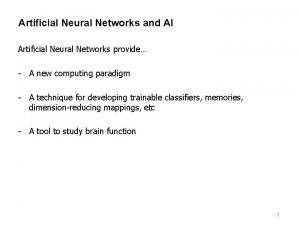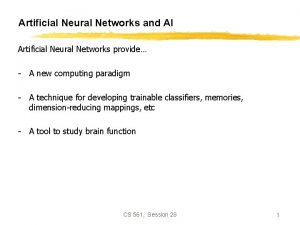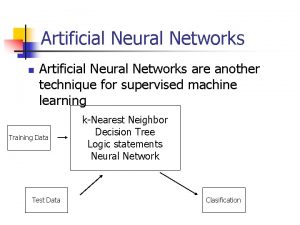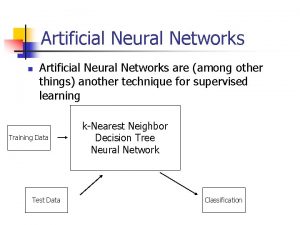Artificial Intelligence Techniques INTRODUCTION TO NEURAL NETWORKS 1














































- Slides: 46

Artificial Intelligence Techniques INTRODUCTION TO NEURAL NETWORKS 1

Aims: Section fundamental theory and practical applications of artificial neural networks.

Aims: Session Aim Introduction to the biological background and implementation issues relevant to the development of practical systems.

Biological neuron Taken from http: //hepunx. rl. ac. uk/~candreop/minos/Neural. N ets/neural. Net. Intro. html

Human brain consists of approx. 10 billion neurons interconnected with about 10 trillion synapses.

A neuron: specialized cell for receiving, processing and transmitting informations.

Electric charge from neighboring neurons reaches the neuron and they add.

The summed signal is passed to the soma that processing this information.

A signal threshold is applied.

If the summed signal > threshold, the neuron fires

Constant output signal is transmitted to other neurons.

The strength and polarity of the output depends features of each synapse

varies these features adapt the network.

varies the input contribute vary the system!

Simplified neuron Taken from http: //www. geog. leeds. ac. uk/people/a. turner/pr ojects/medalus 3/Task 1. htm

Exercise 1 In groups of 2 -3, as a group: Write down one question about this topic?

Mc. Culloch-Pitts model X 1 W 1 X 2 W 2 X 3 W 3 Y T Y=1 if W 1 X 1+W 2 X 2+W 3 X 3 T Y=0 if W 1 X 1+W 2 X 2+W 3 X 3<T

Mc. Culloch-Pitts model Y=1 if W 1 X 1+W 2 X 2+W 3 X 3 T Y=0 if W 1 X 1+W 2 X 2+W 3 X 3<T

Logic functions - OR X 1 1 Y 1 X 2 1 Y = X 1 OR X 2

Logic functions - AND X 1 1 X 2 1 2 Y = X 1 AND X 2 Y

Logic functions - NOT X -1 Y = NOT X Y 0

Mc. Culloch-Pitts model X 1 X 2 X 3 W 1 W 2 T W 3 Y=1 if W 1 X 1+W 2 X 2+W 3 X 3 T Y=0 if W 1 X 1+W 2 X 2+W 3 X 3<T Y

Introduce the bias Take threshold over to the other side of the equation and replace it with a weight W 0 which equals -T, and include a constant input X 0 which equals 1.

Introduce the bias Y=1 if W 1 X 1+W 2 X 2+W 3 X 3 - T 0 Y=0 if W 1 X 1+W 2 X 2+W 3 X 3 -T <0

Introduce the bias Lets just use weights – replace T with a ‘fake’ input ‘fake’ is always 1.

Introduce the bias Y=1 if W 1 X 1+W 2 X 2+W 3 X 3 +W 0 X 0 0 Y=0 if W 1 X 1+W 2 X 2+W 3 X 3 +W 0 X 0 <0

Short-hand notation Instead of writing all the terms in the summation, replace with a Greek sigma Σ Y=1 if W 1 X 1+W 2 X 2+W 3 X 3 +W 0 X 0 0 Y=0 if W 1 X 1+W 2 X 2+W 3 X 3 +W 0 X 0 <0 becomes

Logic functions X 0 - OR -1 X 1 Y 1 X 2 1 Y = X 1 OR X 2

Logic functions - AND X 0 -2 X 1 Y 1 X 2 1 Y = X 1 AND X 2

Logic functions - NOT X 0 0 Y X 1 -1 Y = NOT X 1

The weighted sum The weighted sum, Σ Wi. Xi is called the “net” sum. Net = Σ Wi. Xi y=1 if net 0 y=0 if net < 0

Multi-layered perceptron Feedback network Train by passing error backwards Input-hidden-output layers Most common

Multi-layered perceptron (Taken from Picton 2004) Input layer Output layer Hidden layer

Hopfield network Feedback network Easy to train Single layer of neurons Neurons fire in a random sequence

Hopfield network x 1 x 2 x 3

Radial basis function network Feedforward network Has 3 layers Hidden layer uses statistical clustering techniques to train Good at pattern recognition

Radial basis function networks Input layer Output layer Hidden layer

Kohonen network All neurons connected to inputs not connected to each other Often uses a MLP as an output layer Neurons are self-organising Trained using “winner-takes all”

What can they do? Perform tasks that conventional software cannot do For example, reading text, understanding speech, recognising faces

Neural network approach Set up examples of numerals Train a network Done, in a matter of seconds

Learning and generalising Neural networks can do this easily because they have the ability to learn and to generalise from examples

Learning and generalising Learning is achieved by adjusting the weights Generalisation is achieved because similar patterns will produce an output

Summary Neural networks have a long history but are now a major part of computer systems

Summary They can perform tasks (not perfectly) that conventional software finds difficult

Introduced Mc. Culloch-Pitts model and logic Multi-layer preceptrons Hopfield network Kohenen network

Neural networks can Classify Learn and generalise.
 Searching techniques in artificial intelligence
Searching techniques in artificial intelligence Newff matlab toolbox
Newff matlab toolbox Convolutional neural network
Convolutional neural network Netinsights
Netinsights Pxdes
Pxdes Cpsc 322: introduction to artificial intelligence
Cpsc 322: introduction to artificial intelligence Cpsc 322: introduction to artificial intelligence
Cpsc 322: introduction to artificial intelligence Pengertian artificial neural network
Pengertian artificial neural network Artificial neural network in data mining
Artificial neural network in data mining Artificial neural network terminology
Artificial neural network terminology Conclusion of artificial neural network
Conclusion of artificial neural network Visualizing and understanding convolutional networks
Visualizing and understanding convolutional networks Fat shattering dimension
Fat shattering dimension Merzenich et al (1984) ib psychology
Merzenich et al (1984) ib psychology Audio super resolution using neural networks
Audio super resolution using neural networks Convolutional neural networks for visual recognition
Convolutional neural networks for visual recognition Image style transfer using convolutional neural networks
Image style transfer using convolutional neural networks Efficient processing of deep neural networks pdf
Efficient processing of deep neural networks pdf Deep neural networks and mixed integer linear optimization
Deep neural networks and mixed integer linear optimization Least mean square algorithm in neural network
Least mean square algorithm in neural network Pixel recurrent neural networks.
Pixel recurrent neural networks. Neural networks for rf and microwave design
Neural networks for rf and microwave design 11-747 neural networks for nlp
11-747 neural networks for nlp Xor problem
Xor problem Sparse convolutional neural networks
Sparse convolutional neural networks On the computational efficiency of training neural networks
On the computational efficiency of training neural networks Threshold logic unit
Threshold logic unit Fuzzy logic lecture
Fuzzy logic lecture Convolutional neural networks
Convolutional neural networks Few shot learning with graph neural networks
Few shot learning with graph neural networks Deep forest: towards an alternative to deep neural networks
Deep forest: towards an alternative to deep neural networks Convolutional neural networks
Convolutional neural networks Neuraltools neural networks
Neuraltools neural networks Gated recurrent unit in deep learning
Gated recurrent unit in deep learning Predicting nba games using neural networks
Predicting nba games using neural networks Neural networks and learning machines
Neural networks and learning machines The wake-sleep algorithm for unsupervised neural networks
The wake-sleep algorithm for unsupervised neural networks Audio super resolution using neural networks
Audio super resolution using neural networks Alternatives to convolutional neural networks
Alternatives to convolutional neural networks Mycin advantages and disadvantages
Mycin advantages and disadvantages Iterative deepening search prolog
Iterative deepening search prolog Searching for solutions in artificial intelligence
Searching for solutions in artificial intelligence 15-780 graduate artificial intelligence
15-780 graduate artificial intelligence Knowledge manipulation in artificial intelligence
Knowledge manipulation in artificial intelligence Types of knowledge in artificial intelligence
Types of knowledge in artificial intelligence Colbert, stephen. home page. 1 nov. 2006.
Colbert, stephen. home page. 1 nov. 2006. Artificial intelligence leadership
Artificial intelligence leadership
